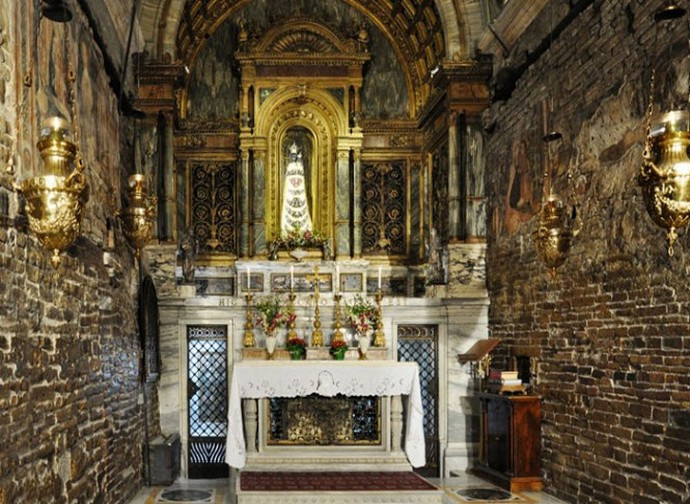Blessed Virgin Mary of Loreto
Today the Church commemorates the relocation of the Holy House of Nazareth, which on December 10 1294 was flown by angels in the Marche region, then part of the Papal States.

Today the Church commemorates the relocation of the Holy House of Nazareth, which on December 10 1294 was flown by angels in the Marche region, then part of the Papal States. It was not the first miraculous relocation nor would it be the last, so it is worth mentioning the historical context in which it happened.
In May of 1291 the city of Nazareth and the whole of Palestine were under the dominion of the Seljuk Turks, who were a threat both to the pilgrims and to the holy places where Christ lived, taught and suffered the Passion for our salvation. It was then that to preserve the Holy House, where Mary was born and where the Word of God became incarnate following the fiat spoken by the Virgin before the Archangel Gabriel (Lk 1: 26-38), the angels took it from its foundations and transferred it to Trsat, in Dalmatia. It remained there for three years and seven months (“but there it was not at all honored as was appropriate for the Virgin,” reads a chronicle of 1465 by Pier Giorgio Tolomei, who had gotten the news from an old ‘tabula’ dating back to the beginning of the 14th century), until December 10 1294, when the Holy House was placed for the first time on the land of the Vicar of Christ.
In the following two years the sacred dwelling was moved three more times to nearby places, first because of brigands who were robbing the faithful and then because two brothers (the Counts Stefano and Simone Rinaldi) had tried to obtain the deed of ownership over the Holy House, which in the end the angels placed in the middle of the road that goes from Recanati to its port: and this, note well, forced the magistrates of the time to order a detour of the route. In that place, later called Loreto, the Holy House still stands today after more than seven centuries, protected by a marble covering inside the homonymous basilica, which was erected beginning in the 15th century and has become one of the most-visited Marian shrines in the world, a pilgrimage destination for pontiffs, cardinals, kings, queens and millions of other faithful who have left gifts and ex voto offerings there for the countless graces received.
From the 13th century to the present day, both in Loreto and in Nazareth, numerous archaeological and historical studies on the Holy House have been conducted which support the supernatural nature of the relocation. Completely made up, on the other hand, are the modern (and modernist) stories, even accompanied by the production - from the 19th century onwards - of false records, which would have it that the relocation was done by crusaders or by an alleged “Angeli” or “De Angelis” family. We will briefly mention the facts that verify the miraculous relocation.
Among the most recent research is that of Father Bellarmino Bagatti, one of the most important archaeologists of the 20th century, of Nereo Alfieri, also a famous archaeologist, and of Nanni Monelli (La Santa Casa a Loreto, La Santa Casa a Nazareth), an architect and engineer. First of all, in its original core, the house consists of only three walls because it was set up against a cave with which it constituted a single housing unit. The measurements of the house of Loreto and the thickness of its walls correspond perfectly to the foundations that are found in Nazareth, in the place that for thirteen centuries has been venerated by the faithful as the house of Mary. The stones of the Holy House are typical of Palestine and worked with a technique specific to those places; to this it must be added that in the Marche there were no stone quarries and all the buildings were made of bricks, not to mention that the location of the door on the long wall and the orientation of the entire house are anomalies in terms of the construction practices of the time in the Marche region.
The stones of the Holy House turn out to be bound with a mortar also typical of Palestine, consisting of gypsum mixed with charcoal powder through a technique never used in Italy, and uniform in all points: another fact which, as explained by electrochemistry professor Emanuele Mor, excludes the hypothesis of a removal and relocation of the house by human hands, because “if a new reinstallation of the single blocks of stone had occurred, it would be apparent by the difference in the chemical composition of the mortar in question.” On the stones there are numerous graffiti that bear Christological signs (including the inscription in Hebrew "O Jesus Christ, Son of God") very similar to those found in Nazareth in the earliest centuries of Christianity.
These and several other details converge toward the only plausible conclusion, the daughter of reason illuminated by faith: the Holy House of Loreto, relocated by the angels, is the same as that of Nazareth where the mystery took place that is at the center of salvation history, the Incarnation of Our Lord Jesus Christ. And on account of the presence of this tangible sign in our midst we should shed tears of gratitude: because - as John Paul II said - it is “the universal home of all the adopted children of God. The history of every man, in a certain sense, passes through that house.”
For more information:
- Il Miracolo della Santa Casa di Loreto, by Federico Catani, Luci sull'Est, 2018




